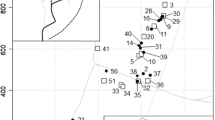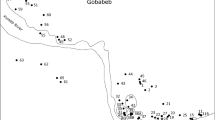Summary
Nests ofTapinoma minutum were collected and mapped from a wet sclerophyll forest in New South Wales during the spring, summer, and fall seasons. Queen number was variable, indicating the population is both facultatively polygynous and polydomous. Electrophoretic data from three polymorphic enzymes revealed that relatedness among workers conformed to the Hamiltonian expectation of 0.75. Colony boundaries were inferred from electrophoretic data synthesized with nest spatial locations. For this species colonies were composed of at most three nests; this simple pattern of polydomy suggests it has a recent origin in this population. The pattern of facultative polygyny may be linked to an apparent high rate of colony orphaning.
Similar content being viewed by others
References
Andersen, A., 1982. Seed removal by ants in the mallee of northwestern Victoria. In:Ant-plant interactions in Australia. (R. C. Buckley, Ed.), Dr. W. Junk, publishers, The Hague, pp. 31:73.
Beattie, A. J., 1985.The evolutionary ecology of ant-plant mutualisms. Cambridge Univ. Press.
Briese, D. T., 1983. Different modes of reproductive behavior (including a description of colony fission) in a species ofChelaner (Hymenoptera: Formicidae).Ins. Soc. 30:308–316.
Brown, W. L., Jr. and R. W. Taylor, 1970. Superfamily Formicoidea. In:The Insects of Australia, CSIRO. Melbourne Univ. Press, pp. 951–959.
Buckley, R. C., 1982.Ant-plant interactions in Australia. Dr. W. Junk, The Hague.
Crozier, R. H., P. Pamilo and Y. C. Crozier, 1984. Relatedness and microgeographic genetic variation inRhytidoponera mayri, an Australian arid-zone ant.Behav. Ecol. Sociobiol. 15:143–150.
Del Rio Pesado, M. G. and T. M. Alloway, 1983. Polydomy in the slave-making antHarpagoxenus americanus (Emery) (Hymenoptera: Formicidae).Psyche 90:151–162.
Fletcher, D. C. and K. G. Ross, 1985. Regulation of reproduction in eusocial hymenoptera.Ann Rev. Entomol. 30:319–343.
Haering, R. and B. J. Fox, 1987. Short-term coexistence and long-term competitive displacement of two dominant species ofIridomyrmex: the successional response of ants to regenerating habitats.J. Anim. Ecol. 56:495–507.
Hamilton, W. D., 1964. The genetical theory of social behavior I, II.J. Theor. Biol. 7:1–52.
Herbers, J. M., 1984. Queen-worker conflict and eusocial evolution in a polygynous ant species.Evolution 38:631–643.
Herbers, J. M., 1985. Seasonal structuring of a north temperate ant community.Ins. Soc. 32:224–240.
Herbers, J. M., 1986a. Effects of ecological parameters on queen number inLeptothorax longispinosus (Hymenoptera: Formicidae).J. Kans. Ent. Soc. 59:675–686.
Herbers, J. M., 1986b. Nest site limitation and facultative polygyny in the antLeptothorax longispinosus.Behav. Ecol. Sociobiol. 19:115–122.
Herbers, J. M., 1989. Community structure in north temperate ants: temporal and spatial variation.Oecologia 81:201–211.
Herbers, J. M. and C. W. Tucker, 1986. Population fluidity inLeptothorax longispinosus (Hymenoptera: Formicidae).Psyche 93:217–229.
Hölldobler, B. and E. O. Wilson, 1977. The number of queens: an important trait in ant evolution.Naturwiss. 64:8–15.
Hölldobler, B. and E. O. Wilson, 1990.The Ants. Belknap Press, Cambridge MA.
Pamilo, P., 1989. Estimating relatedness in social groups.Trends Ecol. Evol. 4:353–355.
Pamilo, P. and R. Rosengren, 1984. Evolution of nesting strategies of ants: genetic evidence from different population types ofFormica ants.Biol. J. Linn. Soc. 21:331–348.
Peeters, C. and S. Higashi, 1989. Reproductive dominance controlled by mutilation in the queenless antDiacamma australe.Naturwiss. 76:177–180.
Queller, D. C. and K. F. Goodnight, 1989. Estimation of genetic relatedness using allozyme data.Evol. 43:258–275.
Rissing, S. W. and G. B. Pollock, 1988. Pleometrosis and polygyny in ants. In:Interindividual Behavioral Variability in Social Insects. (R. Jeanne, Ed.), Westview Press, Boulder, CO, pp. 179–222.
Snyder, L. E. and J. M Herbers, 1991. Sex ratios and colony fraction fractionation in the antMyrmica punctiventris. Behav. Ecol. Sociobiol. (in press).
Stuart, R. J., 1985. Spontaneous polydomy in laboratory colonies of the antLeptothorax curvispinosus Mayr. (Hymenoptera: Formicidae).Psyche 92:71–81.
Taylor, R. W. 1974. Superfamily Formicoidea. In:The Insects of Australia, CSIRO Supplement. Melbourne Univ Press, p. 111.
Taylor, R. W., 1978.Nothomyrmecia macrops: a living-fossil ant rediscovered.Science 201:979–985.
Traniello, J. F. A. and S. C. Levings, 1986. Intra- and intercolony patterns of nest dispersion in the antLasius neoniger: correlations with territoriality and foraging ecology.Oecologia 69:413–419.
Tschinkel, W. R. and D. F. Howard, 1978. Queen replacement in orphaned colonies of the fire antSolenopsis invicta.Behav. Ecol. Sociobiol. 3:297–310.
Ward, P. S., 1981a. Ecology and life history of theRhytidoponera impressa groups (Hymenoptera: Formicidae). I. Habitats, nest sites, and foraging behavior.Psyche 88:89–108.
Ward, P. S., 1981b. Ecology and life history of theRhytidoponera impressa groups (Hymenoptera: Formicidae). II. Colony origin, seasonal cycles, and reproduction.Psyche 88:109–126.
Author information
Authors and Affiliations
Rights and permissions
About this article
Cite this article
Herbers, J.M. The population biology ofTapinoma minutum (Hymenoptera: Formicidae) in Australia. Ins. Soc 38, 195–204 (1991). https://doi.org/10.1007/BF01240969
Received:
Accepted:
Issue Date:
DOI: https://doi.org/10.1007/BF01240969




